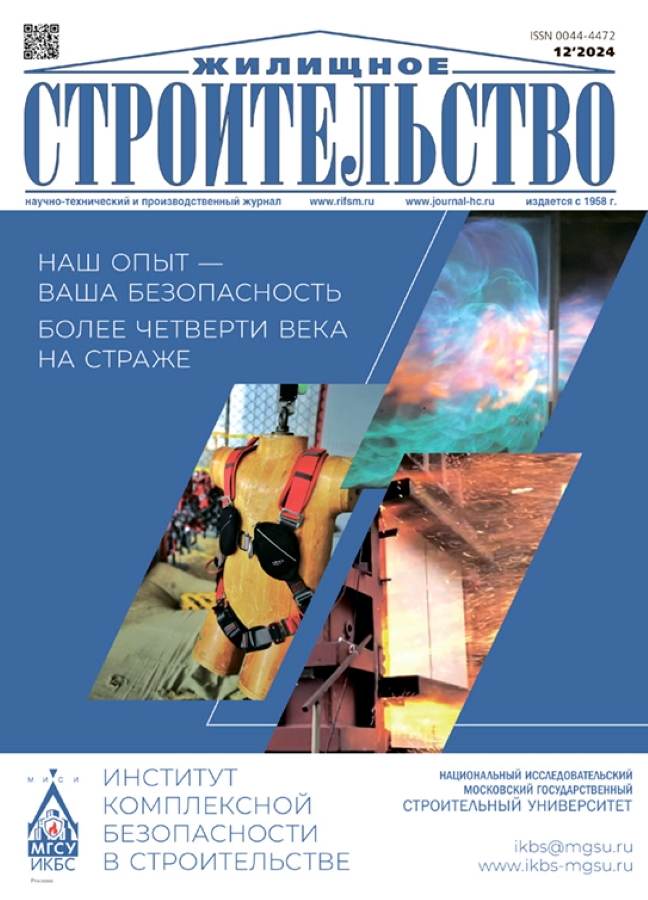Application of strength theories in assessing the stress-strain state of steel-concrete structures
- 作者: Khazov P.А.1, Pomazov A.P.1, Sitnikova A.K.1, Dubov A.L.1
-
隶属关系:
- Nizhny Novgorod State University of Architecture and Civil Engineering
- 期: 编号 12 (2024)
- 页面: 49-54
- 栏目: Articles
- URL: https://ter-arkhiv.ru/0044-4472/article/view/646403
- DOI: https://doi.org/10.31659/0044-4472-2024-12-49-54
- ID: 646403
如何引用文章
详细
Currently, there is a development of high-rise and unique construction, which requires the study of new composite materials, the development of new calculation methods, and the introduction of innovative technologies. Pipe-concrete structures are a successful combination of two completely different materials – steel and concrete, combining their advantages. .In the experimental part, pipe-concrete samples with a length of 100 mm were tested with an axial compressive load. The shell pipe and the concrete core were also tested separately. Based on the results of the experiments, longitudinal deformation diagrams are constructed, which are compared with the deformation of a hollow steel pipe. Stress components in a steel cage and a concrete core are determined using the dependencies of the theory of small elastic-plastic deformations. The applicability of classical strength theories has been evaluated to assess the stress-strain state of a core in a state of triaxial compression and a steel shell experiencing tensile circumferential stresses from the internal pressure of the core on the pipe walls. An experimental evaluation of the obtained results was performed.
全文:
作者简介
P. Khazov
Nizhny Novgorod State University of Architecture and Civil Engineering
编辑信件的主要联系方式.
Email: khazov.nngasu@mail.ru
Candidate of Sciences (Engineering)
俄罗斯联邦, 65, Ilinskaya Street, Nizhny Novgorod, 603950A. Pomazov
Nizhny Novgorod State University of Architecture and Civil Engineering
Email: pomazov.a.p@yandex.ru
Postgraduate Student
俄罗斯联邦, 65, Ilinskaya Street, Nizhny Novgorod, 603950A. Sitnikova
Nizhny Novgorod State University of Architecture and Civil Engineering
Email: khazov.nngasu@mail.ru
Postgraduate Student
俄罗斯联邦, 65, Ilinskaya Street, Nizhny Novgorod, 603950A. Dubov
Nizhny Novgorod State University of Architecture and Civil Engineering
Email: khazov.nngasu@mail.ru
Student
俄罗斯联邦, 65, Ilinskaya Street, Nizhny Novgorod, 603950参考
- Rimshin V.I., Krishan A.L., Astaf’eva M.A. Studies of the bearing capacity of centrally compressed concrete filled steel tubes. Zhilishchnoe Stroitel’stvo [Housing Construction]. 2022. No. 6, pp. 33–38. (In Russian). EDN: OZWOAC. https://doi.org/10.31659/0044-4472-2022-6-33-38
- Khazov P.A., Sitnikova A.K., Chibakova E.A. Calculation of pipe-concrete structures: the current state of the issue and prospects for further research (review). Privolzhskiy nauchnyy zhurnal. 2023. No. 4 (68), pp. 57–76. (In Russian). EDN: NESSKL
- Ovchinnikov I.I., Ovchinnikov I.G., Chesnokov G.V., Mihaldykin E.S. On the problem of calculating pipe-concrete structures with a shell made of different materials. Part 1. Experience in the use of pipe concrete with a metal shell. Internet-zhurnal Naukovedenie. 2015. Vol. 7. No. 4, p. 91. (In Russian). EDN: UMATZX
- Tamrazyan A.G., Manaenkov I.K. Testing of small diameter concrete filled steel tube samples with high reinforcement coefficient. Stroitel’stvo i rekonstrukciya. 2017. No. 4 (72), pp. 57–62. (In Russian). EDN: ZHHHIZ
- Belyj G.I., Vedernikova A.A. Issledovanie prochnosti i ustojchivosti trubobetonnyh elementov konstrukcij obratnym chislenno-analiticheskim metodom. Vestnik grazhdanskih inzhenerov. 2021. No. 2 (85), pp. 26–35. (In Russian). EDN: VGEQAE. https:// doi.org/10.23968/1999-5571-2021-18-2-26-35
- Krishan A.L., Astafeva M.A., Rimshin V.I. et al. Compressed Reinforced Concrete Elements Bearing Capacity of Various Flexibility. Lecture Notes in Civil Engineering. 2022. Vol. 182, pp. 283–291. https:// doi.org/10.1007/978-3-030-85236-8_26
- Zhang S., Miao K., Wei Y. et al. Experimental and Theoretical Study of Concrete-Filled Steel Tube Columns Strengthened by FRP/Steel Strips Under Axial Compression. International Journal of Concrete Structures and Materials. 2023. 17, 1. https://doi.org/10.1186/s40069-022-00556-2
- Lazovic Radovanovic M.M., Nikolic J.Z., Radovanovic J.R., Kostic S.M. Structural Behaviour of Axially Loaded Concrete-Filled Steel Tube Columns during the Top-Down Construction Method. Applied Sciences. 2022. No. 12 (8), 3771. https:// doi.org/10.3390/app12083771
- Pengfei Li, Tao Zhang, Chengzhi Wang. Behavior of Concrete-Filled Steel Tube Columns Subjected to Axial Compression. Hindawi, Advances in Materials Science and Engineering. 2018. 15 p. https:// doi.org/10.1155/2018/4059675
- Kido Masae, Tsuda Keigo, Haraguchi Masayuki. Ultimate strength of concrete filled square steel tubular beam-columns. Journal of Structural and Construction Engineering (Transactions of AIJ). 2020, pp. 415–425. https://doi.org/10.3130/aijs.85.415
- Khazov P.A., Pomazov A.P. Experimental study of longitudinal and transverse bending of pipe concrete rods. Zhilishchnoe Stroitel’stvo [Housing Constructions]. 2023. No. 12, pp. 66–72. (In Russian). EDN: ANFJDO. https://doi.org/10.31659/0044-4472-2023-12-66-71
- Khazov P.A. Triaxial stress state of concrete under longitudinal deformation of tube-concrete samples. Problemy prochnosti i plastichnosti. 2023. Vol. 85. No. 2, pp. 5–15. (In Russian). EDN: FXDPIW. https://doi.org/10.32326/1814-9146-2023-85-2-312-322
补充文件










